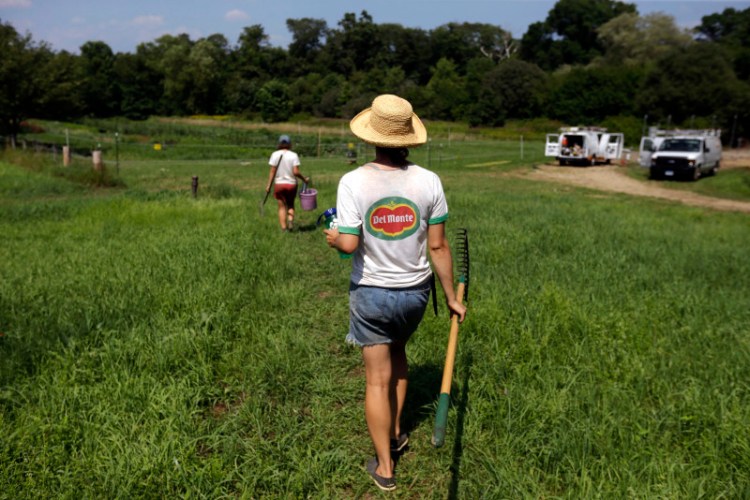CRANSTON, R.I. — Farming is hip in New England.
Across the region, young people are choosing crops over cubicles, new farms are popping up and the local food movement is spreading.
Farmers and industry experts agree New England is bucking a trend toward larger, but fewer, farms because many of its residents want to buy their food locally and its entrepreneurs want to produce it. The region’s small size makes it easy for farmers and consumers to connect at farm markets and stands.
Many of these new farmers are young people increasingly interested in the origins of their food and farming, who are eager to take over for the nation’s aging farmers.
“The more I scratched the surface on what was going on with the food system, the more I felt a compulsion to act,” said 32-year-old Bill Braun, who runs the Ivory Silo farm in Massachusetts. He is not using his graduate degree in philosophy because, he said, he felt an urgent need to grow his own food and reconnect with nature.
He was among a group of farmers and future farmers, mostly in their 20s and 30s, who recently talked about seed collecting as they meandered through rows of vegetables at Scratch Farm’s “Young Farmer Night” in Cranston.
There is something empowering, Braun said, about making a statement by farming a small plot of land. He worries about the environmental impacts and other problems stemming from industrial agriculture.
The U.S. Department of Agriculture’s recent census found 95,000 fewer farms nationally in 2012 than in 2007. But New England saw a 5 percent increase to nearly 35,000 farms, many less than 50 acres.
The number of beginning farmers also climbed in New England. The small but densely populated region is the “perfect place” for farmers to respond to the growing interest in local foods, said Ginger Harris, a USDA statistician.
Squash, eggplant and other vegetables are popular; fruits often cannot be harvested the first few seasons, and the upfront costs for livestock can be high. And many farmers avoid synthetic pesticides and fertilizers.
Scratch Farm, which is chemical-free, has eggplants selling for about $3 per pound, higher than the local Whole Foods Market at $1.99 per pound and the supermarket at $1.49 per pound this week.
Despite what can be higher prices, Jesse Rye, of Farm Fresh Rhode Island, said the idea of supporting local food resonates with New Englanders. Farm Fresh is a nonprofit that helps local food producers bring their goods to market through farmers markets and other programs.
“We already know a great deal about farmers simply through our proximity,” Rye said. “These are our neighbors.”
Each week, John and Lauren Galoski drive about 40 minutes from their home in Warwick to Wright’s Dairy Farm in North Smithfield to buy milk. They said they like supporting local businesses and feel the milk is healthier for their young son. The farm does not treat cows with synthetic hormones to increase milk production and has been recognized within the industry for producing high-quality milk.
At the century-old dairy farm, customers lately ask more questions about the milk and the cows. Teenagers want to work there. Fourth-generation farmer Ellen Puccetti said that when she was young, she was teased for living on a farm.
“It’s very, very exciting after all this time to see that kind of movement, to see that kind of excitement, especially from young people,” she said.
David Lizotte, 22, took a job there as a farm hand over a year ago to get experience for the Peace Corps. Lizotte said he still may join but loves how challenging and fun his work is.
The National Young Farmers Coalition wants to ensure farming’s revival is not fleeting. The New York-based coalition is lobbying for policy changes to help beginning farmers get capital and find affordable land.
With a farm population ready to retire, executive director Lindsey Shute said, it’s critical that farms transition to a new generation.
States in the Northeast saw a 43 percent increase on average in the number of undergraduate students studying agriculture from 2004 to 2012. The only region that topped it was the West. Connecticut had the largest percentage increase nationwide— nearly 200 percent, to more than 2,100 students.
Cameron Faustman, an associate dean at the University of Connecticut’s agriculture college, said students see job opportunities. Less than 2 percent of the students come from working farms.
At the Young Farmer Night, Emily Cotter, 22, an agriculture student and farm hand in Rhode Island, said she, like many of her peers, has found farming to be an intellectual, physically demanding, fulfilling job.
“I think it’s cool, too,” she said. “But that’s because I’m a farmer.”
Send questions/comments to the editors.



Success. Please wait for the page to reload. If the page does not reload within 5 seconds, please refresh the page.
Enter your email and password to access comments.
Hi, to comment on stories you must . This profile is in addition to your subscription and website login.
Already have a commenting profile? .
Invalid username/password.
Please check your email to confirm and complete your registration.
Only subscribers are eligible to post comments. Please subscribe or login first for digital access. Here’s why.
Use the form below to reset your password. When you've submitted your account email, we will send an email with a reset code.